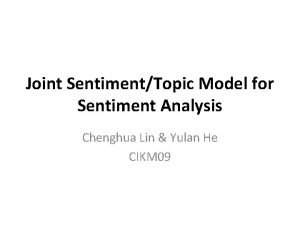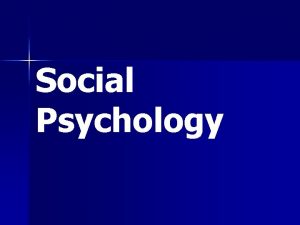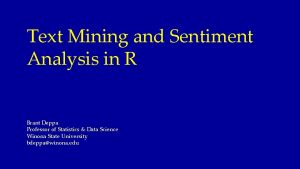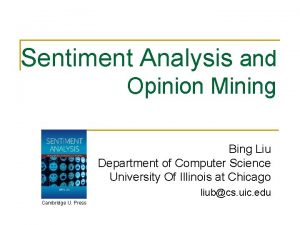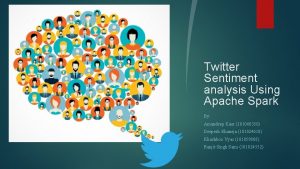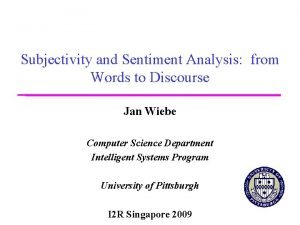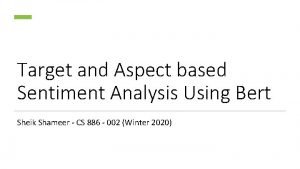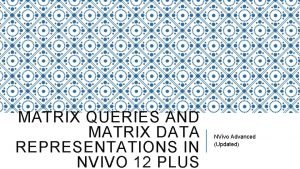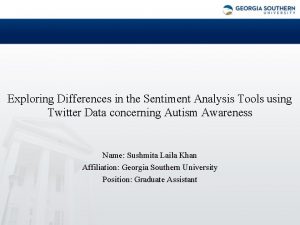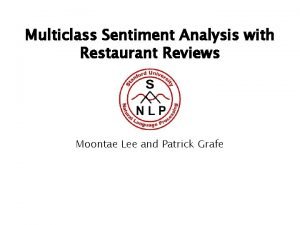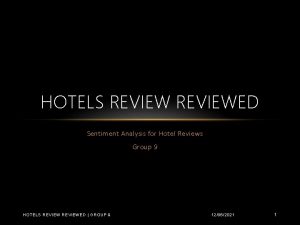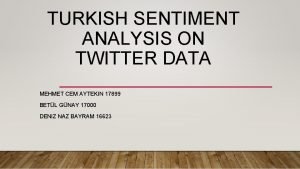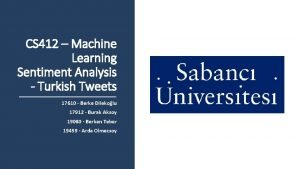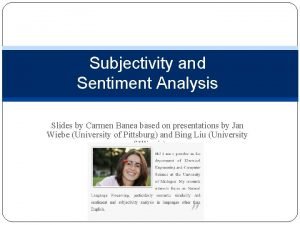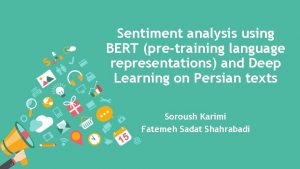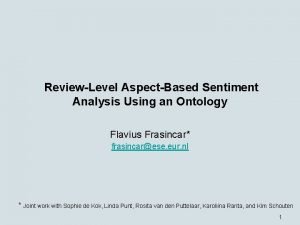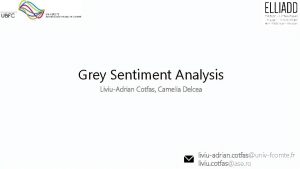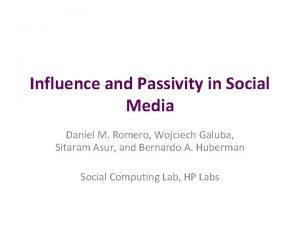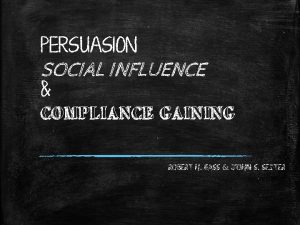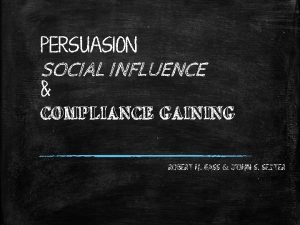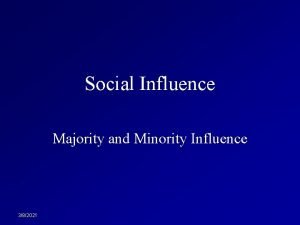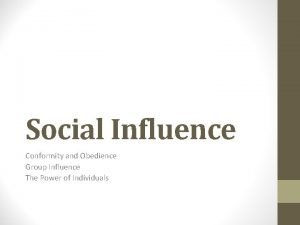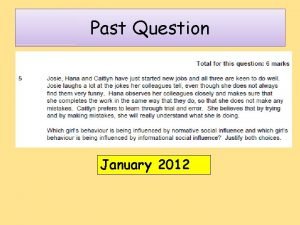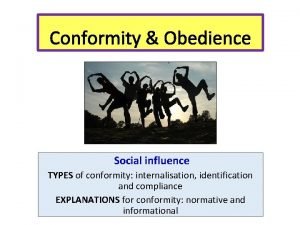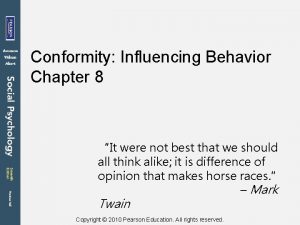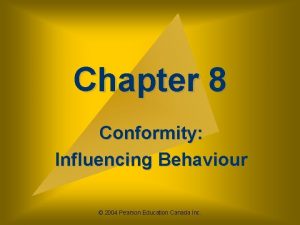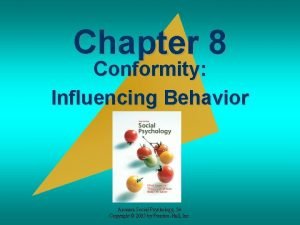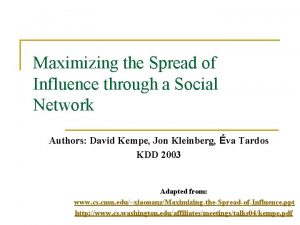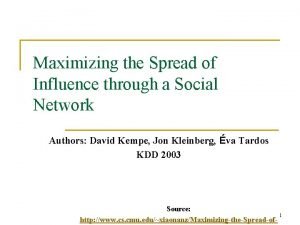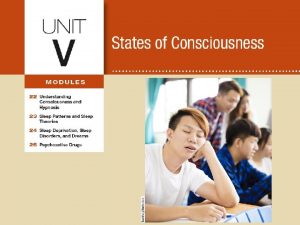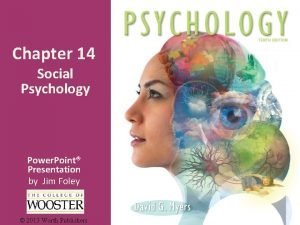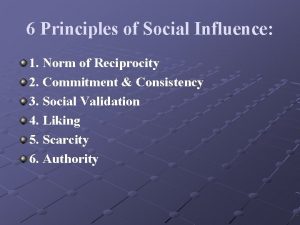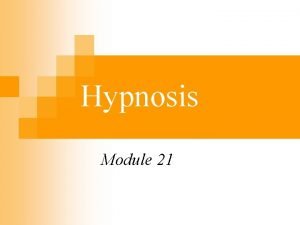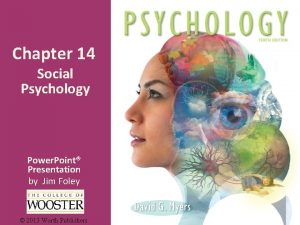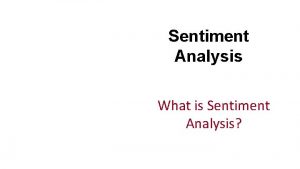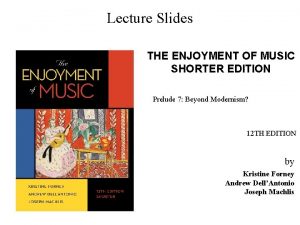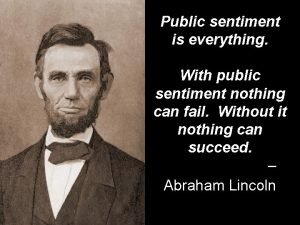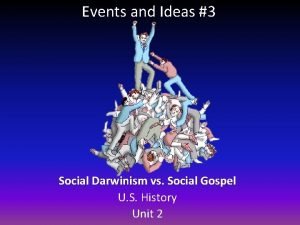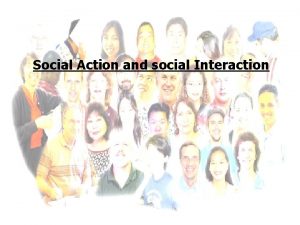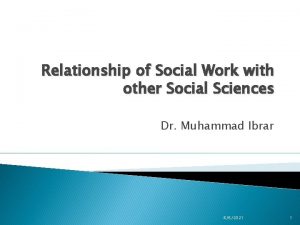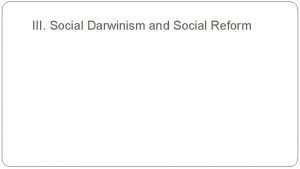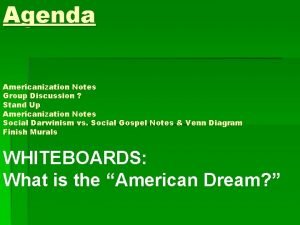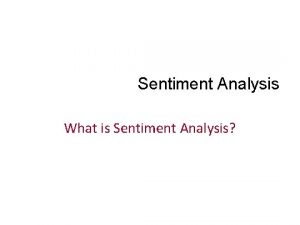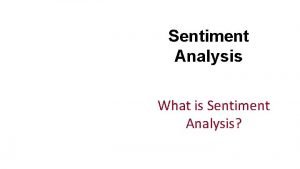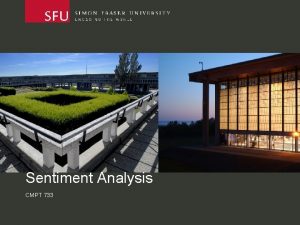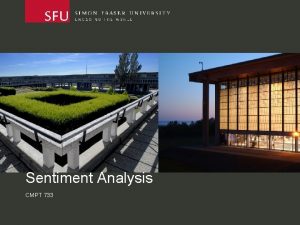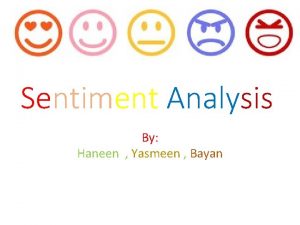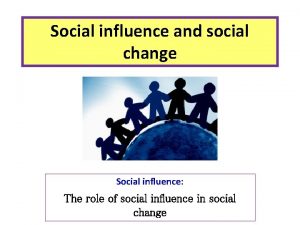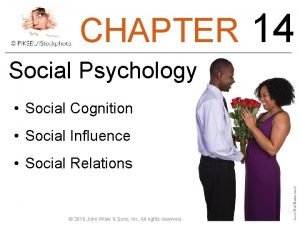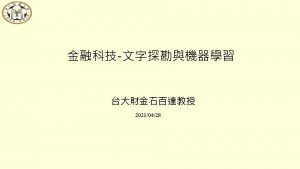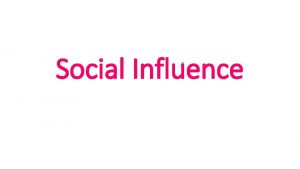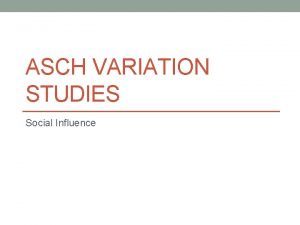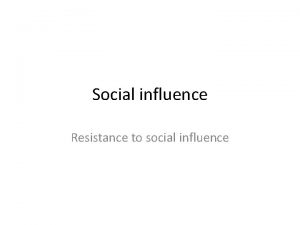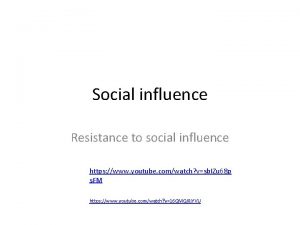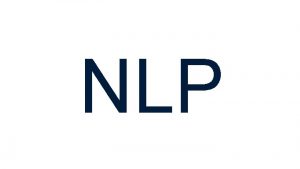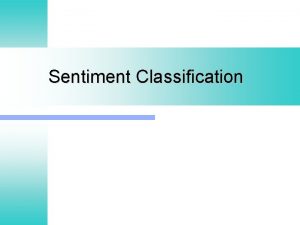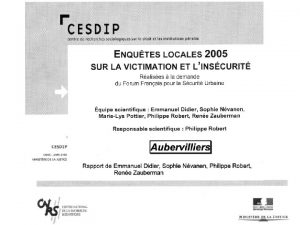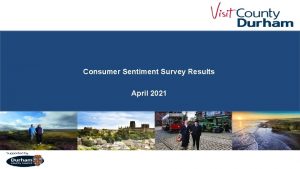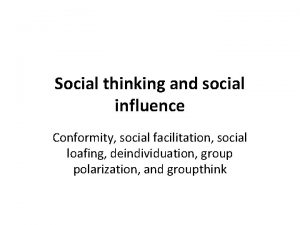Social Influence and Sentiment Analysis From Sentiment to




![Does Social Influence really matter? • Case 1: Social influence and political mobilization[1] – Does Social Influence really matter? • Case 1: Social influence and political mobilization[1] –](https://slidetodoc.com/presentation_image_h2/3d1ad448652a50012f1ddfa917268b3a/image-5.jpg)





































![Problem [1] Yang, Jia, Shumei Zhang, Boya Wu, Qicong Chen, Juanzi Li, Chunxiao Xing, Problem [1] Yang, Jia, Shumei Zhang, Boya Wu, Qicong Chen, Juanzi Li, Chunxiao Xing,](https://slidetodoc.com/presentation_image_h2/3d1ad448652a50012f1ddfa917268b3a/image-43.jpg)
![Emotion Learning Method [1] Yang, Jia, Shumei Zhang, Boya Wu, Qicong Chen, Juanzi Li, Emotion Learning Method [1] Yang, Jia, Shumei Zhang, Boya Wu, Qicong Chen, Juanzi Li,](https://slidetodoc.com/presentation_image_h2/3d1ad448652a50012f1ddfa917268b3a/image-44.jpg)








- Slides: 52

Social Influence and Sentiment Analysis —From Sentiment to Emotion Analysis in Social Networks Jie Tang Department of Computer Science and Technology Tsinghua University, China

Networked World • 1. 65 billion MAU (users) • 2. 5 trillion minutes/month • 255 million MAU • Peak: 143 K tweets/s • 304 million active users • 14 billion items/year 2 • QQ: 800 million MAU • We. Chat: 700 million MAU • 220 million users • influencing our daily life • 710 million trans. on 11/11 • 13. 6 billion USD in 24 hrs

The Era of Big Social Data • We generate 2. 5 x 1018 byte big data per day. Number of Social Network Users Worldwide (Billion) 2. 5 28% Global Population Penetration Rate 2 2. 13 1. 79 1. 5 1. 22 1 1. 4 1. 59 2. 29 1. 96 2. 4 Hours Spent on Social Media each day 0. 97 0. 5 2010 • 2011 2012 2013 2014 2015 2016 2017 Big social data: – 90% of the data was generated in the past 2 yrs – Mining in single data center mining deep knowledge from multiple data sources http: //www. statista. com/statistics 3 http: //www. globalwebindex. net/

User Opinion and Influence: “Love Obama” I hate Obama, the worst president ever I love Obama is fantastic Obama is great! No Obama in 2012! He cannot be the next president! Positive 4 Negative
![Does Social Influence really matter Case 1 Social influence and political mobilization1 Does Social Influence really matter? • Case 1: Social influence and political mobilization[1] –](https://slidetodoc.com/presentation_image_h2/3d1ad448652a50012f1ddfa917268b3a/image-5.jpg)
Does Social Influence really matter? • Case 1: Social influence and political mobilization[1] – Will online political mobilization really work? A controlled trial (with 61 M users on FB) - Social msg group: was shown with msg that indicates one’s friends who have made the votes. - Informational msg group: was shown with msg that indicates how many other. - Control group: did not receive any msg. [1] R. M. Bond, C. J. Fariss, J. J. Jones, A. D. I. Kramer, C. Marlow, J. E. Settle and J. H. Fowler. A 61 -million-person 5 experiment in social influence and political mobilization. Nature, 489: 295 -298, 2012.

Case 1: Social Influence and Political Mobilization Social msg group v. s. Info msg group Result: The former were 2. 08% (ttest, P<0. 01) more likely to click on the “I Voted” button Social msg group v. s. Control group Result: The former were 0. 39% (ttest, P=0. 02) more likely to actually vote (via examination of public voting records) [1] R. M. Bond, C. J. Fariss, J. J. Jones, A. D. I. Kramer, C. Marlow, J. E. Settle and J. H. Fowler. A 61 -million-person 6 experiment in social influence and political mobilization. Nature, 489: 295 -298, 2012.

Twitter Data • Twitter – 1, 414, 340 users and 480, 435, 500 tweets – 274, 644, 047 t-follow edges and 58, 387, 964 @ edges [1] Chenhao Tan, Lillian Lee, Jie Tang, Long Jiang, Ming Zhou, and Ping Li. User-level sentiment analysis incorporating 7 networks. In KDD’ 11, pages 1397– 1405, 2011. social

From text sentiment to user sentiment Positive Obama is making the repubs look silly and petty. Negative Classifier with dictionary However, the social text is really short and noisy … User A Only thing we have 2 fear is Obama himself & Pelosi & Cong & liberal news & Dems &. . . Barack Obama can no more disown ACORN than he could disown his own grandmother. 8 User-level Sentiment Analysis Positive Negative Classifier

From user sentiment to network sentiment 1 Who influenced who? What is the 2 Can we leverage the social influence probability? to help sentiment analysis? I hate Obama, the worst president ever I love Obama is fantastic 0. 74 0. 3 0. 2 Obama is great! 0. 1 0. 05 0. 4 0. 1 No Obama in 2012! 0. 7 He cannot be the next president! Positive 9 Negative

Sentiment Influence in Twitter Shared sentiment conditioned on type of connection. —people tend to follow the opinion of their friends [1] Chenhao Tan, Lillian Lee, Jie Tang, Long Jiang, Ming Zhou, and Ping Li. User-level sentiment analysis incorporating 10 networks. In KDD’ 11, pages 1397– 1405, 2011. social

Selection Connectedness conditioned on labels —people tend to create relationships with other people who share the same opinion with them 11

Learning for network sentiment analysis I hate Obama, the worst president ever I love Obama is fantastic No Obama in 2012! Obama is great! He cannot be the next president! Positive Negative Networked Classification Model: Learning for sentiment analysis by considering the network information Another challenge: labeled data is very limited… 12

Semi-supervised Factor Graph Model Semi-FGM: learning to classify sentiments by considering both content and network structure in a semi-supervised fashion. Social link Tweets by user v 3 indicate our confidence level in labeled/unlabeled users User-specific attributes [1] Chenhao Tan, Lillian Lee, Jie Tang, Long Jiang, Ming Zhou, and Ping Li. User-level sentiment analysis incorporating 13 networks. In KDD’ 11, pages 1397– 1405, 2011. social

Semi-supervised Factor Graph Model Semi-FGM: learning to classify sentiments by considering both content and network structure in a semi-supervised fashion. Social link Tweets by user v 3 indicate our confidence level in network-based influence User-user factor [1] Chenhao Tan, Lillian Lee, Jie Tang, Long Jiang, Ming Zhou, and Ping Li. User-level sentiment analysis incorporating 14 networks. In KDD’ 11, pages 1397– 1405, 2011. social

Semi-supervised Factor Graph Model + 15

Parameter Estimation for Semi-FGM • “No. Learning”: simply use counts from the labeled subset of the data the subset of edges in our dataset in which both endpoints are labeled indicator function • Sample. Rank (“Learning”): A sampling-based learning algorithm using Metropolis–Hastings 16

Sample. Rank (“Learning”) likelihood ratio of new sample Ynew and previous label Y for all users Update model parameters when two results are inconsistent Relative performance between new sample Ynew and previous label Y on labeled user only. 17

Results of network sentiment analysis • Twitter – 1, 414, 340 users and 480, 435, 500 tweets – 274, 644, 047 t-follow edges and 58, 387, 964 @ edges • Methods – SVM Vote – Semi-FGM (No. Learning) – Semi-FGM (Sample. Rank) • Measures – Accuracy and Macro F 1 18

19

Performance 20

Performance Analysis in Different Topics 21

Results of Different Learning Algorithms 22

Twitter to Weibo 23

We have a picture of sentiment analysis in social networks… • From text sentiment to user sentiment • From user sentiment to network sentiment • Challenges: – Short text and noisy data – Limited labeled data – Networked user sentiments • Proposal of a Semi-supervised Factor Graph Model (Semi-FGM) to learn to classify sentiments by considering both content and network structure 24

Now, let us think… • What are the fundamental factors behind – What is behind the network of social users? – What is behind the sentiment of social users? 25

Well, what is the fundamental factor… Info. Space vs. Social Space Info. Space Interaction From the social network research perspective, what are the fundamental factors behind? Social Space Understanding the mechanism of interaction dynamics 26

Topic-based Social Influence Analysis Topics Market Strategy I hate Obama Politics Entertainment Trademarks Positive I love Obama Negative How to? output Politics 0. 3 0. 7 0. 2 0. 4 0. 5 0. 1 0. 05 0. 1 27 0. 74

The Solution: Topical Affinity Propagation Market Strategy Market Basic Idea: If a user is located in the center of a “Market” community, and is “similar” to the other users, then she/he would have a strong influence on the other users. —Homophily theory Strategy [1] Jie Tang, Jimeng Sun, Chi Wang, and Zi Yang. Social Influence Analysis in Large-scale Networks. In KDD, pages 807 28 2009. -816,

The Solution: Topical Affinity Propagation Define a function to quantify the similarity between neighborhood users Market Strategy How “Ada” thought he influenced “Bob”? Politics How “Bob” thought he was influenced by “Ada”? Politics Estimate how a user can represent his neighbors Market Strategy Politics Market Strategy The topic information can be obtained by any tagging system or topic modeling approach [1] Jie Tang, Jimeng Sun, Chi Wang, and Zi Yang. Social Influence Analysis in Large-scale Networks. In KDD, pages 807 29 2009. -816,

Topical Factor Graph (TFG) Model Social link Asymmetric similarity Topological feature or global constraint Nodes that have the highest influence on the current node User-specific attributes Node/user The problem is cast as identifying which node has the highest probability to influence another node on a specific topic along with the edge. 30

Topical Factor Graph (TFG) Objective function: 1. How to define? 2. How to optimize? • The learning task is to find a configuration for all {yi} to maximize the joint probability. 31

How to define (topical) feature functions? similarity – Node feature function – Edge feature function or simply binary – Global feature function 32

Model Learning Algorithm Sum-product: - Low efficiency! - Not easy for distributed learning! 33

New TAP Learning Algorithm 1. Introduce two new variables r and a, to replace the original message m. 2. Design new update rules: How user i thought he influenced user j? mij How user j thought he was influenced by user i? [1] Jie Tang, Jimeng Sun, Chi Wang, and Zi Yang. Social Influence Analysis in Large-scale Networks. In KDD, pages 807 34 2009. -816,

The TAP Learning Algorithm 35

Experiments • Data&Codes: (http: //arnetminer. org/lab-datasets/soinf/) Data set #Nodes Coauthor 640, 134 1, 554, 643 Citation 2, 329, 760 12, 710, 347 Film (Wikipedia) 18, 518 films 7, 211 directors 10, 128 actors 9, 784 writers 142, 426 • Evaluation measures – CPU time – Case study – Application 36 #Edges

Social Influence Sub-graph on “Data mining” On “Data Mining” in 2009 37

Now, let us think… • What are the fundamental factors behind – What is behind the network of social users? – What is behind the sentiment of social users? What drives users’ sentiments? 38

Sentiment vs. Emotion is the driving force of user’s sentiments… Charles Darwin: – Emotion serves as a purpose for humans in aiding their survival during the evolution. [1] Emotion stimulates the mind 3000 times quicker than rational thought! [1]39 Charles Darwin. The Expression of Emotions in Man and Animals. John Murray, 1872.

Potential Directions • From sentiment to emotion analysis? • Add social theories into emotion analysis? • Sentiment/emotion analysis for “Social Good”? 40

Was Anna Happy When She Published This Photo On Flickr? A lovely doorplate Anna: a girl who just graduated 41

Was Anna Happy When She Published This Photo On Flickr? 42
![Problem 1 Yang Jia Shumei Zhang Boya Wu Qicong Chen Juanzi Li Chunxiao Xing Problem [1] Yang, Jia, Shumei Zhang, Boya Wu, Qicong Chen, Juanzi Li, Chunxiao Xing,](https://slidetodoc.com/presentation_image_h2/3d1ad448652a50012f1ddfa917268b3a/image-43.jpg)
Problem [1] Yang, Jia, Shumei Zhang, Boya Wu, Qicong Chen, Juanzi Li, Chunxiao Xing, and Jie Tang. How Do Your 43 Friends on Social Media Disclose Your Emotions? In AAAI'14. pp. 306 -312.
![Emotion Learning Method 1 Yang Jia Shumei Zhang Boya Wu Qicong Chen Juanzi Li Emotion Learning Method [1] Yang, Jia, Shumei Zhang, Boya Wu, Qicong Chen, Juanzi Li,](https://slidetodoc.com/presentation_image_h2/3d1ad448652a50012f1ddfa917268b3a/image-44.jpg)
Emotion Learning Method [1] Yang, Jia, Shumei Zhang, Boya Wu, Qicong Chen, Juanzi Li, Chunxiao Xing, and Jie Tang. How Do Your 44 Friends on Social Media Disclose Your Emotions? In AAAI'14. pp. 306 -312.

Flickr Data • 354, 192 images posted by 4, 807 users – For each image, we also collect its tags and all comments. – Thus we get 557, 177 comments posted by 6, 735 users in total • Infer emotion of users by considering both image and tag/comments 45

Emotion Inference Average ly +37. 4 % in terms of F 1 SVM: regards the visual features of images as inputs and uses a SVM as a classifier. PFG: considers both color features and social correlations among images. LDA+SVM: first uses LDA to extract latent topics from comments, then uses visual features, topic distributions, and social ties as features to train a SVM. 46

To What Extend Your Friends Can Disclose Your Emotions? -Comments stands for the proposed method ignoring comment information -Tie ignores social tie information Fear images have similar visual features with Sadness and Anger. Homophily suggests that friends with similar interests tend to have similar understanding of disgust 47

Image Interpretations • Our model demonstrates how visual features distribute over different emotions. (e. g. , images representing Happiness have high saturation) • Positive emotions attract more response (+4. 4 times) and more easily to influence others compared with negative emotions. 48

Potential Directions • From sentiment to emotion analysis? • Add social theories into emotion analysis? • Sentiment/emotion analysis for “Social Good”? 49

Summary • • 50 From text sentiment to user sentiment From user sentiment to network sentiment From sentiment analysis to emotion analysis From network interaction to social influence

Related Publications • • • 51 Jie Tang, Jimeng Sun, Chi Wang, and Zi Yang. Social Influence Analysis in Large-scale Networks. In KDD'09, pages 807 -816, 2009. Chenhao Tan, Lillian Lee, Jie Tang, Long Jiang, Ming Zhou, and Ping Li. User-level sentiment analysis incorporating social networks. In KDD’ 11, pages 1397– 1405, 2011. Jie Tang, Sen Wu, and Jimeng Sun. Confluence: Conformity Influence in Large Social Networks. In KDD'13, pages 347 -355, 2013. Yang, Jia, Shumei Zhang, Boya Wu, Qicong Chen, Juanzi Li, Chunxiao Xing, and Jie Tang. How Do Your Friends on Social Media Disclose Your Emotions? In AAAI'14. pp. 306 -312. Jie Tang, Yuan Zhang, Jimeng Sun, Jinghai Rao, Wenjing Yu, Yiran Chen, and ACM Fong. Quantitative Study of Individual Emotional States in Social Networks. IEEE Transactions on Affective Computing (TAC), 2012, Volume 3, Issue 2, Pages 132 -144. (Selected as the Spotlight Paper) Xiaohui Wang, Jia, Jie Tang, Boya Wu, Lianhong Cai, and Lexing Xie. Modeling Emotion Influence in Image Social Networks. IEEE Transactions on Affective Computing (TAC), Volume 6, Issue 3, 2015, Pages 286 -297. Yuan Zhang, Jie Tang, Jimeng Sun, Yiran Chen, and Jinghai Rao. Mood. Cast: Emotion Prediction via Dynamic Continuous Factor Graph Model. In ICDM’ 10. pp. 1193 -1198. Jia, Sen Wu, Xiaohui Wang, Peiyun Hu, Lianhong Cai, and Jie Tang. Can We Understand van Gogh’s Mood? Learning to Infer Affects from Images in Social Networks. In ACM MM, pages 857 -860, 2012. Xiaohui Wang, Jia, Peiyun Hu, Sen Wu, Lianhong Cai, and Jie Tang. Understanding the Emotional Impact of Images. (Grand Challenge) In ACM MM. pp. 1369 -1370. (Grand Challenge 2 nd Prize Award)

Thank you! Collaborators: Lillian Lee, Chenhao Tan (Cornell) Jinghai Rao (Nokia) Jimeng Sun (IBM/GIT) Ming Zhou, Long Jiang (Microsoft) Yuan Zhang, Jia, Yang, Boya Wu, Xiaohui Wang (THU) Jie Tang, KEG, Tsinghua U, Download all data & Codes, http: //keg. cs. tsinghua. edu. cn/jietang http: //aminer. org/data-sna
 Joint sentiment topic model for sentiment analysis
Joint sentiment topic model for sentiment analysis Social thinking social influence social relations
Social thinking social influence social relations Social thinking social influence social relations
Social thinking social influence social relations Social thinking and social influence in psychology
Social thinking and social influence in psychology Social thinking theories
Social thinking theories Text mining and sentiment analysis in r
Text mining and sentiment analysis in r Opinion definition
Opinion definition Apache spark twitter
Apache spark twitter Subjectivity in sentiment analysis
Subjectivity in sentiment analysis Sentihood
Sentihood What is nvivo used for
What is nvivo used for Sentiment analysis tools comparison
Sentiment analysis tools comparison Sentiment analysis of restaurant reviews
Sentiment analysis of restaurant reviews Hotel review analysis
Hotel review analysis Turkish sentiment analysis
Turkish sentiment analysis Turkish sentiment analysis
Turkish sentiment analysis Azure twitter sentiment analysis
Azure twitter sentiment analysis What is subjectivity in sentiment analysis
What is subjectivity in sentiment analysis Unsupervised sentiment analysis using bert
Unsupervised sentiment analysis using bert Sentiment analysis conclusion
Sentiment analysis conclusion Github liviu cotfas
Github liviu cotfas Influence and passivity in social media
Influence and passivity in social media Group dynamics communication
Group dynamics communication Borderline persuasion examples
Borderline persuasion examples Robert h gass persuasion download
Robert h gass persuasion download Examples of informational social influence
Examples of informational social influence Conversion social influence example
Conversion social influence example Normative social influence
Normative social influence Examples of informational social influence
Examples of informational social influence Social norms examples
Social norms examples 3 types of conformity
3 types of conformity What is informational social influence in psychology
What is informational social influence in psychology Informational social influence example
Informational social influence example Informational social influence
Informational social influence Ambiguous social influence
Ambiguous social influence Maximizing the spread of influence through a social network
Maximizing the spread of influence through a social network Maximizing the spread of influence through a social network
Maximizing the spread of influence through a social network Module 22 understanding consciousness and hypnosis
Module 22 understanding consciousness and hypnosis Example of social influence
Example of social influence Social influence principles
Social influence principles Ap psychology unit 14
Ap psychology unit 14 Divided consciousness theory of hypnosis
Divided consciousness theory of hypnosis Examples of social influence
Examples of social influence Influence diagram structural analysis
Influence diagram structural analysis Twitter sentiment
Twitter sentiment Chapter 67 neo romantic evocations
Chapter 67 neo romantic evocations Public sentiment is everything
Public sentiment is everything Abolitionist sentiment grows
Abolitionist sentiment grows Social darwinism vs social gospel
Social darwinism vs social gospel Difference between social action and social interaction pdf
Difference between social action and social interaction pdf Social work relationship with other social sciences
Social work relationship with other social sciences Lesson 3 social darwinism and social reform
Lesson 3 social darwinism and social reform Social darwinism vs social gospel venn diagram
Social darwinism vs social gospel venn diagram
